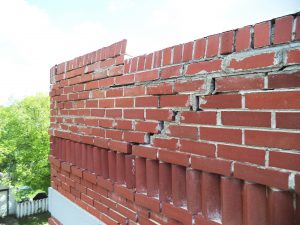Buildings are complex structures made up of countless systems, materials, machines and components. It’s no surprise that sometimes things can go awry. Whether a failure was the result of a severe weather incident, general deterioration or a major design flaw, at some point every building owner is faced with a catastrophe.
And when it comes to those catastrophes, Bob Korneluk, Associate with RJC Engineers, has seen the gamut. “Forensic engineers can be called on to investigate a variety of failures,” he explains. “In our field of practice, those failures are typically building structure and building envelope failures. These failures may be caused by flooding or fires, but in many cases they are caused by deficient workmanship or design, which can lead to bigger problems as the building ages—like excessive corrosion or moisture damage of the building structure and envelope components.”
Generally, the purpose of a forensic engineering investigation is to determine the root cause of a building failure and how it may be addressed, with the intent of improving the performance of the building. It can also be to determine if a building does not meet the building code, and if a violation has occurred, how that might be rectified.
“If a building suffers fire damage, for example, we may be called in to review the structural integrity of the remaining structure or assess the level of damage to the building envelope,” Korneluk says. “We don’t usually assess the cause of the fire. That is typically done by a fire department or the local Code Authority (AHJ), but they could call us in to review a building’s design and construction if they have determined that there were code violations. Depending on our findings, we may be called on to testify as an expert witness. Sometimes our findings even lead to criminal charges.”
As for more common scenarios, roof leaks tend to be something forensic engineers are called in to assess regularly. “Often reports of a leakage will come in during the winter or the first spring thaw,” he says. “But after our investigation, we may determine that the leakage was from condensation and not water penetration. From there, we’ll recommend a repair program to reduce the amount of air leakage into the roof assemblies, which will in turn reduce the amount of condensation and subsequent leakage into the building.”
According to Korneluk, a typical investigation by a forensic engineer includes the following five steps:
1. The engineer gathers as much background information as possible on the building, including existing drawings, reports and other correspondence. Usually he or she would also interview building operators and tenants.
2. A visual assessment is conducted on a part of, or the entire building, with a focus on the apparent failure(s). The scope of this assessment is determined by the type and use of the building.
3. The engineer reviews his or her findings to determine what caused the failure(s).
4. Further testing is conducted if required to narrow down the cause of the failure(s). This could be a water penetration or air leakage test, a thermal scan, or exploratory openings.
5. The engineer’s findings are presented along with recommendations in a formal report.
“After a client has reviewed our report, we are often asked to prepare drawings and specifications for the repair work,” Korneluk says. “These drawings would outline specific repair details, which would then be priced by a qualified contractor.”
 Timeframe, scope and outcome:
Timeframe, scope and outcome:
Clients of forensic engineers can vary between property owners, property managers, insurance companies and lawyers—it all depends on the nature of the investigation. And similarly, the duration of the process all depends on the size of the building and the magnitude of the failure(s). Generally, however, Korneluk estimates that an assessment will take at least a few weeks to complete.
“Formal reports often take longer and will depend on our current workload and time commitments,” he points out. “Overall it could be a month or two from the initial call to the delivery of the report. After that, repair work could take any length of time depending on the scope and how quickly the client wants it done.”
Of course, if the damage is too severe for repair work, a range of follow-through services—such as consulting on demolition and rebuilding—would be offered. But the goal of the forensic engineer is always the same: to uncover the root problem(s) and determine the best path to set things right.
For building owners, the endgame is equally straightforward. As Korneluk puts it, “The sooner a failure is detected and rectified, the more money an owner can save on repairs and future maintenance costs.”
To find out more about forensics engineering, from initial damage assessment through to repairs or rebuild, visit RJC.ca or, contact Bob Korneluk directly.







As an engineer we have to design the structure considering Soil investigation report,the factors the structure has to face during service life like earthquake,flood,landslide,rainfall,winds,waves and current ,fire etc. The foundation and superstructure requires to be designed considering above factors,lesson learnt from the failure in the past .A group of engineers from respective fields shall review the documents during detailed engineering and drawing as per codes and standards and engineering practice before taking up construction work.
Most of failure of steel structure occurs due to corrosion of steel,lack of periodic preventive repair and maintenance,material selection and quality control of work.
If we take care of structure,structure will take care of us